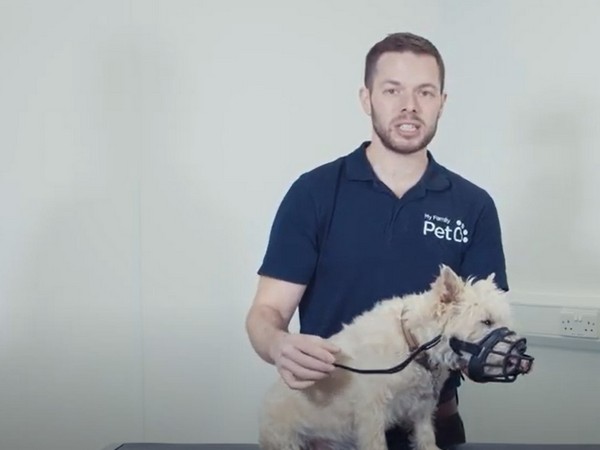Step-by-Step Guide to Muzzle Training Your Dog
First Published: 14/02/2019
Last Updated: 20/01/2025
Muzzling your dog can seem intimidating, but with proper training, you can help them become comfortable and cooperative wearing a muzzle. This comprehensive guide covers everything you need to muzzle train your dog successfully.
When you may need to use a dog muzzle
While proactive muzzle training is ideal for all dogs, certain situations make a muzzle especially necessary for safety and management. These include:
- Vet exams when your dog is in pain or fearful
- Emergency transport or care of an injured or scared dog
- Introductions to new dogs if there are aggression issues
- Grooming with an unfamiliar groomer
- Legally required by breed-specific legislation (see American Bully XL dogs)
In these cases, a muzzle-trained dog will experience less stress. The muzzle protects others while helping keep your dog calm.

Read more: Dog vaccinations: keeping your puppy happy and healthy
Where to buy a dog muzzle
You can buy a range of dog muzzles at the My Family Vets shop. Just click on the link and search for muzzle to see what's available and in-stock. Remember, Pet Health Club members are entitled to a discount. If you want to see a visual guide on how to muzzle train a dog, watch our vet demonstrate the step-by-step process in this helpful video.
Choosing the right muzzle for your dog
There’s lots to consider when choosing the best dog muzzle — do you want a small dog muzzle, or is your dog a large breed that may need something stronger? You might be torn between soft muzzles and hard muzzles. The best thing to do when looking to get a muzzle for your dog is to chat with your vet — they’ll understand your dog and the reasons for needing a muzzle and will be able to alter their recommendations based on this. Proper fit is crucial, so measure your dog’s snout length and circumference. Key muzzle features include:
- Basket style allows panting, drinking, eating
- Custom basket ensures anatomically-contoured fit
- Should not obscure vision or jut into eyes or nose
- Straps should be snug, with room for one finger between the strap and neck
Consult your vet for your dog’s needs when muzzling or muzzle training.
Step-by-step guide on how to muzzle train a dog
Follow this gradual conditioning process to help your dog accept wearing a muzzle:
- Introduce the muzzle gently — let your dog see and sniff the muzzle, then reward them with treats. Don’t try to place the muzzle on the dog, just give treats when your dog interacts with the muzzle.
- Get your dog comfortable with the muzzle — hold the muzzle in your hand and wait for your dog to place their head inside. Once inside, feed the treat to your dog through the side or end of the muzzle. Repeat as often as required until your dog is happy keeping their face in the muzzle.
- Introduce the straps behind the head — instruct your dog to put their head in the muzzle using the treat. Once their head is inside, lift the straps behind their ears without fastening them. This will introduce them to the sensation of the straps. Treat your dog through the muzzle again. Remove the muzzle and repeat this step a few times, still without fastening the straps.
- Fasten the straps — repeat step three, but this time close the clasp of the muzzle behind your dog’s head while the dog's nose is in the muzzle. Undo the clasp straight away and allow them to take their nose out. Rushing at this point could undo all the good work you’ve done so far.
- Gradually increase time in the muzzle — once your dog is comfortable with muzzling, gradually increase the time they wear it. Start with just a few seconds and gradually increase the time until they can wear it for several minutes, always rewarding calm behaviour.
- Keep sessions short — make your muzzle training sessions short, but do them often so they stay fun for your dog and they don’t start thinking of them too much as a bore.
- Go slowly — practice muzzle-wearing during play, walks, commands, and car trips. Vary durations, but take it slowly. If your dog rubs or paws at the muzzle, distract them or remove it temporarily. Seek vet advice if irritation occurs. Never force your dog to wear a muzzle they’re uncomfortable with.
Based on your dog’s progress, begin to leave their muzzle on them for longer periods. Try not to do this randomly. In other words, apply your dog’s muzzle for different lengths of time, in different places and at different times of the day. This will help them accept and understand that the muzzle just comes and goes and that it’s nothing to fear. Never just strap a muzzle onto your dog and force them to accept it — this can cause distress and injury. For particularly fearful dogs, seek guidance from a professional behaviourist.

Read more: Everything you need to know to choose the right dog for you
Troubleshooting muzzle training dogs
If you’re struggling with muzzling a dog, use tasty treats like xylitol-free peanut butter (see image above) and put it at the end of the muzzle on the inside. Feed it to your dog, but don’t attach the muzzle just yet. Once you’ve done this a few times, they’ll form a positive association with their muzzle.
Once your dog is used to voluntarily popping their nose into the muzzle — they don’t jerk away from it or regard it with fear — hold the straps around the back of the head for a second. Feed your dog a treat through the muzzle, then remove it. Build up the time spent holding the straps and feeding treats into the muzzle. You want to form a strong association that the muzzle equals the delivery of tasty things.
Practice makes perfect
Introduce your dog to other dogs while wearing their muzzle and observe their body language to ensure everyone remains relaxed and confident. You can muzzle-train your dog successfully with proper fitting, rewards-based training, and gradual acclimation. Consult your vet if you need additional advice on fitting, styles, or addressing challenges. With patience, you can help your dog feel at ease wearing a muzzle.

Read more: How to help a constipated dog
Do people treat muzzled dogs differently?
Some people may give dogs wearing muzzles more space, but this can be beneficial depending on the reason for the muzzle. If your dog feels anxious around other dogs or people, more space may be helpful. Introduce your dog to other dogs while wearing their muzzle and observe their body language to ensure everyone remains relaxed and confident.
Need more help with dog muzzle training?
You can muzzle-train your dog successfully with proper fitting, rewards-based training, and gradual acclimation. Consult your vet if you need additional advice on fitting, styles, or addressing challenges. With patience, you can help your dog feel at ease wearing a muzzle.
Find your nearest vet using our Find a Vet page, or speak to a vet online using our online vets service.

